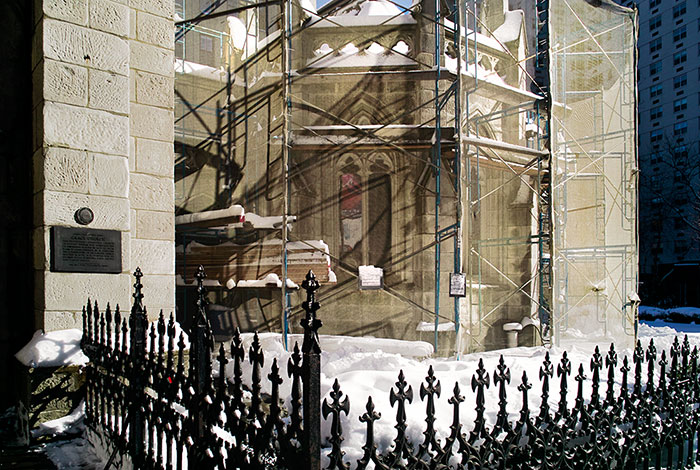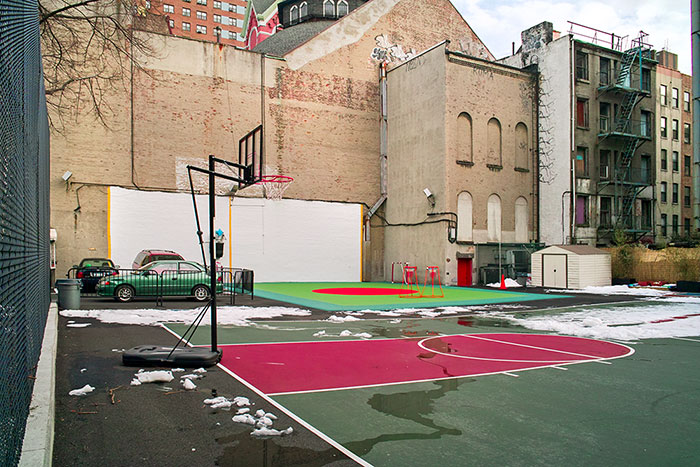Broadway and East 9th Street — © Brian Rose
Ridge Street — © Brian Rose
A few random pictures and random thoughts. As my Lower East Side show approaches I wonder how (or if) the work will be put in context with the photography being made back in the late 70s, and the way in which I connect the work to the present. One of the important points I have tried to make in the book is that the past and present are intertwined, and not neatly separated into before and after as is the usual practice. That said, the photographs I did with Edward Fausty were made as color photography was just beginning to enter the mainstream of art photography. The way we used color and the view camera to describe the streets and architecture of the LES at a particular moment in history had not been done before–at least to my knowledge–and has only been done rarely since. I think of recent work by Robert Polidori in Havana or Andrew Moore in Detroit as examples of the latter. But in 1979 I was thinking about the steady gaze of Atget and Evans with the view camera, and the kinetic energy of Frank and Friedlander with the 35mm.
There’s a book coming out soon called Color Rush by Katherine A. Bussard and Lisa Hostetler that tells the story of color photography from its inception to the early ’80s. The website blurb says: The book begins with the 1907 unveiling of autochrome, the first commercially available color process, and continues up through the 1981 landmark survey show and book The New Color Photography, which hailed the widespread acceptance of color photography in contemporary art.
Alas, my LES work will not be included. It was shown in 1981 in a large exhibition, reviewed in the Times, but then went underground not to be seen again until now with Time and Space on the Lower East Side. I’m not going to go into the reasons why that happened–for the moment–but what I feel good about is that the re-emergence of this work is not primarily a nostalgia trip back to the ruins of the past. It is presented as a fresh portrayal of a place, one that challenges easy assumptions about how to look at the past and how to look at photographs of different eras juxtaposed as they are in Time and Space.
Joerg Colberg on his blog Conscientious recently reviewed the reissue of the book American Prospects by Joel Sternfeld. He states: As a photographer, Sternfeld has certainly had enormous influence on a whole generation of American photographers. For example, it is not hard to see Alec Soth’s Sleeping By The Mississippi follow some of the traces laid out in Sternfeld’s travels and book. The American large-format photography craze might be on the way out now, though – just like its German (Düsseldorf) counterpart it simply appears to have run its course.
I guess there was a craze at some point, but I hate to see things discussed in this off-hand way, that a certain popular style has just run its course, and we can now move on. I’m picking on Joerg here, a thoughtful writer about photography who was writing a positive review of Sternfeld’s book, but for me, my work has little to do with any kind of craze or particular attachment to the influence of contemporary photographers. It has been a long hard slog stretching over decades.
Critics, curators, and the art market are, of course, fond of defining movements and putting things into convenient boxes. A photographer does something innovative, which is then shown in the galleries, the critics jump, and then the art students follow en masse. This is an obvious scenario, but it goes on and on. At any rate, I am proud to be one of the early adopters of color photography dedicated to a descriptive exploration of the landscape. And as I continue to extend my long term projects and begin new ones, I will not accept the notion that looking at the visually tangible world with a critical eye has lost its relevance to contemporary art and culture.
If you stand right fronting and face to face to a fact, you will see the sun glimmer on both its surfaces, as if it were a cimeter, and feel its sweet edge dividing you through the heart and marrow, and so you will happily conclude your mortal career. Be it life or death, we crave only reality. If we are really dying, let us hear the rattle in our throats and feel cold in the extremities; if we are alive, let us go about our business.
–Henry David Thoreau, Walden


Hi Brian, things are arranged for our visit to see you and opening of your show…my thoughts on what you are concerned about are not well versed technically but I think your work in large format is brilliant social commentary both art historically and aesthetically bringing a viewer a kind of all over fascination with the inanimate at a single moment in time I see it as a silent often elegiac witness to human striving for a firm grip on the earth and its axiomatic impossibility to ever be satisfied in that belief. T
Thanks Tim for the kind words. There is a kind of “secular religiosity,” oxymoronically speaking, to being a silent witness. I can’t think of any other reason why I should have kept on with this work for so long.